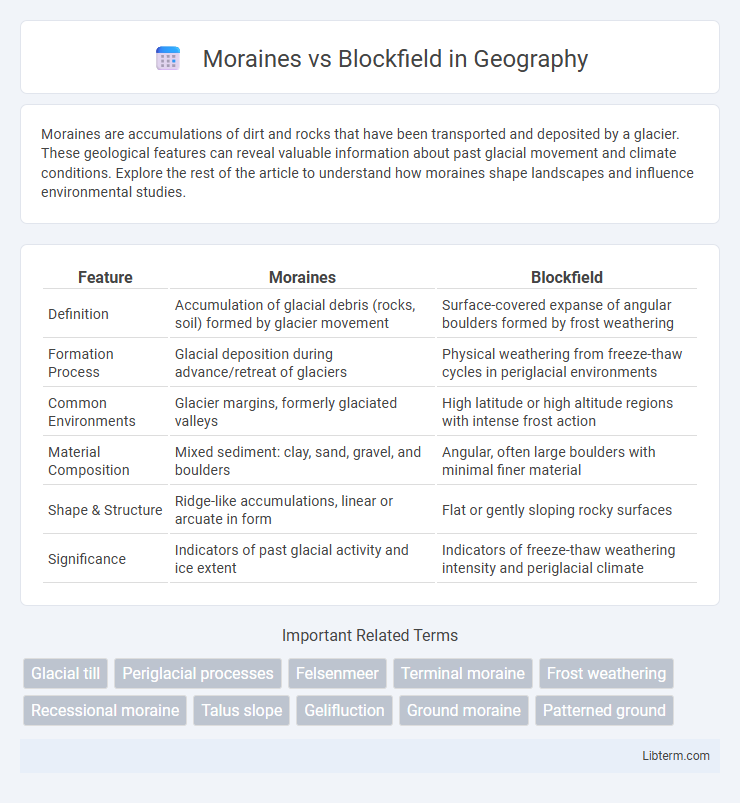Moraines are accumulations of dirt and rocks that have been transported and deposited by a glacier. These geological features can reveal valuable information about past glacial movement and climate conditions. Explore the rest of the article to understand how moraines shape landscapes and influence environmental studies.
Table of Comparison
| Feature | Moraines | Blockfield |
|---|---|---|
| Definition | Accumulation of glacial debris (rocks, soil) formed by glacier movement | Surface-covered expanse of angular boulders formed by frost weathering |
| Formation Process | Glacial deposition during advance/retreat of glaciers | Physical weathering from freeze-thaw cycles in periglacial environments |
| Common Environments | Glacier margins, formerly glaciated valleys | High latitude or high altitude regions with intense frost action |
| Material Composition | Mixed sediment: clay, sand, gravel, and boulders | Angular, often large boulders with minimal finer material |
| Shape & Structure | Ridge-like accumulations, linear or arcuate in form | Flat or gently sloping rocky surfaces |
| Significance | Indicators of past glacial activity and ice extent | Indicators of freeze-thaw weathering intensity and periglacial climate |
Introduction to Moraines and Blockfields
Moraines are accumulations of glacial debris formed by the movement and melting of glaciers, typically consisting of unsorted rock, soil, and sediment deposited at the glacier's edges and terminal points. Blockfields, also known as felsenmeer, are expanses of angular, frost-shattered rock fragments found primarily in periglacial environments, resulting from freeze-thaw weathering processes rather than direct glacial transport. Both landforms provide critical insights into past glacial and climatic conditions but differ significantly in their formation mechanisms and sediment characteristics.
Geological Formation Processes
Moraines form through glacial activity, where debris is transported and deposited by moving ice, creating accumulations of rocks, soil, and sediment at glacier edges or termini. Blockfields develop primarily through frost weathering and freeze-thaw cycles on bedrock surfaces in periglacial environments, resulting in extensive fields of angular rock fragments without glacier transport. These distinct geological formation processes highlight moraines as products of dynamic glacial movement, while blockfields emerge from in situ mechanical breakdown of bedrock in cold climates.
Key Characteristics of Moraines
Moraines are accumulations of glacial debris such as soil and rocks, deposited directly by glacier movement, characterized by their ridged, linear formations along glacier margins. Unlike blockfields, which consist mainly of angular, frost-shattered bedrock spread extensively over flat surfaces, moraines exhibit clear stratification and sorting due to ice transport processes. Key features of moraines include their composition of mixed sediments, distinct layering, and positioning at glacier termini, which serve as indicators of past glacial extents and dynamics.
Distinctive Features of Blockfields
Blockfields are characterized by extensive, angular rock fragments scattered across flat or gently sloping terrains, typically formed through freeze-thaw weathering in cold climates. Unlike moraines, which consist of glacially transported debris arranged in ridges or mounds, blockfields lack clear depositional patterns and show minimal sorting or layering. These distinctive features highlight blockfields as indicators of periglacial processes rather than direct glacial activity.
Environmental and Climatic Influences
Moraines form from glacial sediment accumulation, indicating past glacier movement linked to colder, wetter climates, while blockfields develop through freeze-thaw weathering in periglacial environments characterized by persistent frost and minimal glacial cover. The environmental influence on moraines reflects dynamic ice flow and sediment transport during glacial advances, whereas blockfield formation is dominated by slow mechanical weathering under subzero temperatures and low precipitation. Climatic variations governing temperature and moisture levels determine the prevalence and characteristics of these landforms, with moraines marking glacial extent and blockfields revealing periglacial freeze-thaw cycles.
Geographic Distribution and Occurrence
Moraines are primarily found in glacial regions across North America, Europe, and parts of Asia, where past and present glaciers deposit accumulated rock and sediment along their edges. Blockfields occur predominantly in high-latitude or high-altitude cold environments such as Scandinavia, the Scottish Highlands, and parts of the Alps, formed through prolonged frost weathering and rock disintegration. While moraines indicate active or former glacial movement, blockfields typically represent periglacial processes in non-glaciated or formerly glaciated terrains.
Ecological Impacts of Moraines and Blockfields
Moraines, composed of glacial debris, create unique microhabitats that support specialized plant and microbial communities, influencing local biodiversity and soil formation processes. Blockfields, characterized by expansive rocky surfaces with sparse vegetation, contribute to slower soil development and limited habitat complexity, affecting species distribution and ecosystem resilience. Both landforms play critical roles in shaping ecological succession and nutrient cycling in post-glacial environments.
Importance in Geomorphological Studies
Moraines are essential indicators in geomorphological studies as they reveal past glacial movements and climate change patterns through accumulated rock debris deposited by glaciers. Blockfields, formed primarily by frost weathering in periglacial environments, provide critical insights into weathering processes and landscape evolution in cold climates. Understanding moraines and blockfields enables researchers to reconstruct paleoenvironmental conditions and assess ongoing geomorphological dynamics.
Human Interactions and Utilization
Moraines, formed by glacial debris accumulation, have historically served as fertile grounds for agriculture and settlement due to their nutrient-rich soils and well-drained terrain. Blockfields, consisting of weathered rock fragments typically found in periglacial environments, are less suitable for traditional farming but have been utilized for quarrying building materials and as natural habitats supporting biodiversity. Human interaction with moraines often includes infrastructure development, while blockfields are valued for their ecological significance and geological study.
Summary: Moraines vs Blockfields
Moraines consist of accumulated glacial debris such as rocks and sediment transported and deposited by moving glaciers, typically forming ridges or mounds along glacier edges. Blockfields, also known as felsenmeer, are extensive, flat or gently sloping surfaces covered with large, angular rock fragments formed primarily through frost weathering in periglacial environments without glacier transport. Both landforms indicate past cold-climate processes but differ fundamentally in formation, with moraines representing glacial deposition and blockfields resulting from in situ physical weathering.
Moraines Infographic

 libterm.com
libterm.com